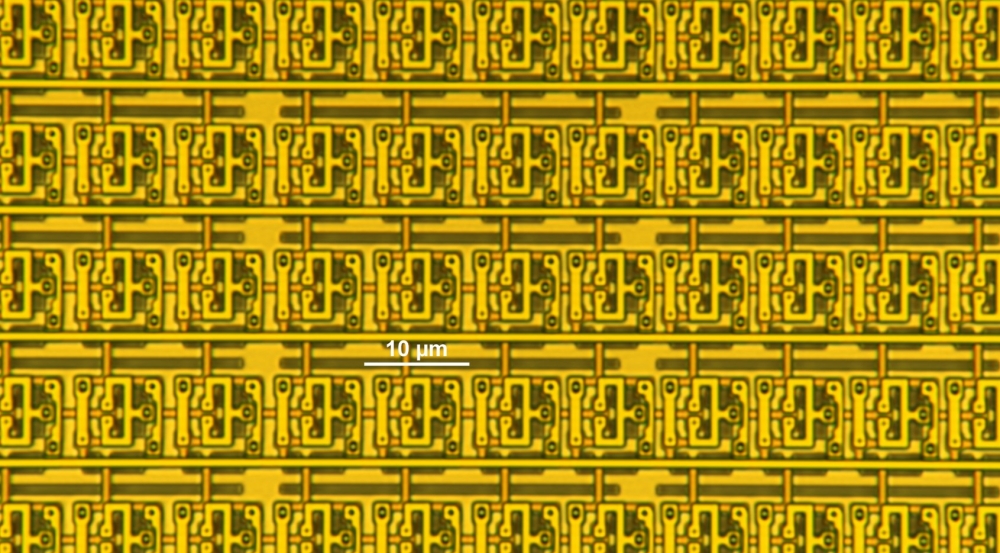I don’t think so? But if this stuff really is caused by precise levels of dopants, it might be possible to “write” circuits into a chip of it in a similar way to how semiconducting chips are made. That’d probably have some interesting applications.
You can’t have a material that is simultaneously semiconducting and superconducting. One of the most sought-after devices in superconductivity is the “superconducting transistor”, a three-terminal device that displays transistor characteristics including true gain,but using the superconducting Bose condensate as the electrical carriers. No one has come up with anything suitable in the past 50 years and there are some good arguments out there that it isn’t possible.
However, just considering the material properties, IIRC, YBCO in the normal state is a (poor) semiconductor.
Definitely more than possible. Superconducting integrated circuit technology has been around for many years (but you don’t use superconducting substrates, mostly you use silicon on which you deposit and pattern superconducting circuits).
Superconducting Integrated Circuits | MIT Lincoln Laboratory
No, you cant!
source: me! (former covid specialist, current Ukraine-war and Superconductor specialist)
As a matter of fact, semiconductor “tests” are being conducted to prove a given material is NOT a SC (or so I read yesterday on a site that also debates if a starcruiser could successfully destroy the Enterprise)
And, I’ll point out, lead is still sold in 50 pound rolls at Home Depot for roof flashing.
(see full thread for further explanation, plus people who don’t believe it’s been disproven)
Too bad, so sad. That does seem conclusive. But it was always a long-shot. The ferromagnetism is somewhat interesting, I suppose.
I’m still waiting on that pyrolytic graphite. But I just found out that bismuth is also diamagnetic. And I have a whole lot of bismuth on hand. I’ll have to build something.
I’m wondering if anyone has tried to find the temperature that this stuff does become superconducting. It’s possible it could do so at some temp above the current record, which might make it useful after all.
One of the replication attempts measured a drop in resistance at ~110 K, but that’s right around the Tc of BSCCO. Plus, the noise floor of the resistance measurement was higher than the resistance of good copper, so it wasn’t even a good indication of superconductivity.
OK, so another group successfully made the same stuff this group did, and this group’s measurements of the crystalline structure were accurate. That seems like a non-story to me: The question was never whether it could be made, or what its crystalline structure was; the question was whether it’s a superconductor.
the results are all over the scale …
that IMHO has to do with the fact that there is no “clear baseline” … e.g. every team might cook up some slightly different base material that does behave slightly different.
but at this stage - it is not a “clearly bogus - 100% debunked” thing …
Ah, I see. If someone else makes the stuff and it’s not a superconductor, then one possible response would be “well, you didn’t make it right”. But if all of the crystallography data matches, then that becomes much less likely.
I also wonder, if only some domains in that sample were superconducting, and that’s why it’s not fully levitating, did it occur to anyone to slice it up into smaller pieces, in the hopes that one of those smaller pieces would be entirely superconducting?
Cold fusion all over again.
No. It’s only been a few weeks since the discovery was announced and the scientific process takes much longer than that for verification. Conversely cold fusion was supposedly discovered in 1989 so there have been decades in which verification could have occurred.
Again it’s too early to be definitive, but:
yes, there seems to be mounting evidence against the claim of a RTSC …
but there also seems to be something remarkable concerning LK-99 … maybe it is somewhat of a (metaphorical) catalytic towards finding one … there def. is a lot of buzz on this topic.
LK-99 isn’t a superconductor — how science sleuths solved the mystery
Replications pieced together the puzzle of why the material displayed superconducting-like behaviours.
Instead, studies have shown that impurities in the material — in particular, copper sulfide — were responsible for the sharp drops in electrical resistivity and partial levitation over a magnet, which looked similar to properties exhibited by superconductors.
It’s just another USO (unidentified superconducting object), a description which was coined in the 90’s, popularized by Bob Cava.
Here’s a blog from 2017 with a little background on USO’s, and you can recognize LK-99 as “common problem 1”.
Condensed concepts: Is it an Unidentified Superconducting Object (USO)?
There have been two common problems:
- Experimental error- due, generally, to inexperienced investigators unfamiliar with measurement methods or what is required to show that a material is superconducting. This has become more rare as the field matures.
It may have been a USO, but I’d say this is science working as designed. The original paper had flaws, but it also gave complete means of replication. Lots of parties attempted the replication, mostly with negative result. And now we have an explanation for why it ever was thought to behave otherwise.
It wasn’t a form of pathological science like cold fusion or the EmDrive, where they were always chasing some very faint signal and it was difficult to classify as real or not. Here, the signal (or lack thereof) was strong.
It remains to be seen if the Korean team keeps pushing on it. It could turn pathological if they trot out ever more unlikely explanations for the behavior. We’ll have to see about that.
